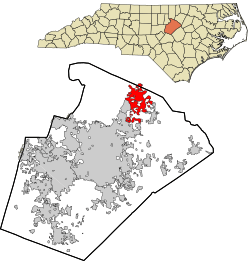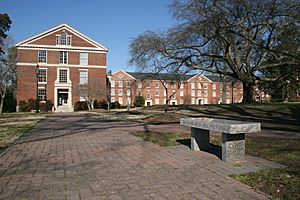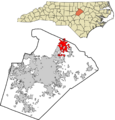Wake Forest, North Carolina facts for kids
Quick facts for kids
Wake Forest
|
||
|---|---|---|

White Street
|
||
|
||

Location in Wake County and the state of North Carolina.
|
||
| Country | United States | |
| State | North Carolina | |
| Counties | Wake, Franklin | |
| Incorporated | 1880 | |
| Named for | The large wooded areas of northern Wake County | |
| Area | ||
| • Total | 19.67 sq mi (50.95 km2) | |
| • Land | 19.52 sq mi (50.55 km2) | |
| • Water | 0.15 sq mi (0.40 km2) 0.76% | |
| Elevation | 295 ft (90 m) | |
| Population
(2020)
|
||
| • Total | 47,601 | |
| • Estimate
(2023)
|
54,337 | |
| • Density | 2,438.83/sq mi (941.62/km2) | |
| Time zone | UTC−5 (Eastern (EST)) | |
| • Summer (DST) | UTC−4 (EDT) | |
| ZIP Codes |
27587–27588
|
|
| Area code(s) | 919, 984 | |
| FIPS code | 37-70540 | |
| GNIS feature ID | 2406816 | |
Wake Forest is a town in North Carolina, a state in the United States. It's mostly in Wake County, just north of Raleigh, the state capital. In 2020, about 47,601 people lived here. Wake Forest used to be home to Wake Forest University for many years. The university moved to Winston-Salem in 1956.
Contents
The Story of Wake Forest
In 1832, a doctor named Calvin Jones bought a large piece of land. This land was covered in forests in Wake County, North Carolina. He built his home there. People started calling this quiet area "the Forest of Wake," or Wake Forest.
Dr. Jones later sold his farm to a group called the North Carolina Baptist Convention. They paid $2,000 for it. On this land, they opened a school called the Wake Forest Manual Labor Institute. This school later became Wake Forest College.
A railroad, the Raleigh & Gaston Railroad, was finished in 1840. It built a station nearby in Forestville. This helped the school and the small village grow. In 1874, the college leaders convinced the railroad to move the station even closer. This led to more growth and businesses.
In 1880, this growing community officially became a town. It was named the "Town of Wake Forest College." In 1909, the word "College" was removed from the town's name. The college itself moved to Winston-Salem in 1956. A new school, Southeastern Baptist Theological Seminary, started using the old college campus in 1950.
Where is Wake Forest Located?
Wake Forest covers about 19.67 square miles (50.95 square kilometers). Most of this area is land, and a small part is water.
The town is in the northeast-central part of North Carolina. This is where two main land regions meet: the Piedmont and the Atlantic Coastal Plain. This meeting point is called the "Fall Line." It's where rivers and creeks start to have waterfalls as the land drops in elevation.
Because of its central location, Wake Forest is about a three-hour drive from Atlantic Beach. It's also about a four-hour drive from the Great Smoky Mountains.
Wake Forest Weather
Wake Forest has a mild subtropical climate. This means spring, fall, and winter usually have comfortable temperatures. Summers are often hot and humid.
In winter, daytime temperatures are usually around 50°F (10-13°C). Nights are typically in the low to mid-30s °F (-2 to 2°C). Sometimes, it can even get warmer, reaching 60°F (15°C) or more. Spring and fall days are usually in the low to mid-70s °F (low 20s °C). Nights are cooler, around the lower 50s °F (10-14°C). In summer, daytime highs often reach the upper 80s to low 90s °F (29-35°C). The months with the most rain are July and August.
People of Wake Forest
| Historical population | |||
|---|---|---|---|
| Census | Pop. | %± | |
| 1880 | 456 | — | |
| 1890 | 858 | 88.2% | |
| 1900 | 823 | −4.1% | |
| 1910 | 1,443 | 75.3% | |
| 1920 | 1,425 | −1.2% | |
| 1930 | 1,536 | 7.8% | |
| 1940 | 1,562 | 1.7% | |
| 1950 | 3,704 | 137.1% | |
| 1960 | 2,664 | −28.1% | |
| 1970 | 3,148 | 18.2% | |
| 1980 | 3,780 | 20.1% | |
| 1990 | 5,769 | 52.6% | |
| 2000 | 12,588 | 118.2% | |
| 2010 | 30,117 | 139.3% | |
| 2020 | 47,601 | 58.1% | |
| 2023 (est.) | 54,337 | 80.4% | |
| U.S. Decennial Census | |||
Population in 2020
| Group | Number | Percentage |
|---|---|---|
| White (not Hispanic) | 32,087 | 67.41% |
| Black or African American (not Hispanic) | 7,480 | 15.71% |
| Native American | 88 | 0.18% |
| Asian | 1,751 | 3.68% |
| Pacific Islander | 24 | 0.05% |
| Other/Mixed | 2,402 | 5.05% |
| Hispanic or Latino | 3,769 | 7.92% |
In 2020, there were 47,601 people living in Wake Forest. They lived in 14,732 households, which included 11,104 families.
Arts and Culture in Wake Forest
Performing Arts
Every fall, Wake Forest hosts the annual Wake Forest Dance Festival. This event takes place at E. Carroll Joyner Park.
Historic Places to Visit
The DuBois Center is a special building listed on the National Register of Historic Places. The W. E. B. DuBois School opened in 1926. It was a school for the African-American community in Wake Forest. This was before schools stopped being separated by race in 1971.
After the school moved to a bigger building, the DuBois Center was empty for ten years. Then, the DuBois Alumni Association bought the building. They turned it into a community center for everyone to use.
Many other places in or near Wake Forest are also listed on the National Register of Historic Places. These include the Bailey-Estes House, Downtown Wake Forest Historic District, and the Wake Forest Historic District.
The Wake Forest Historical Museum is also known as the Dr. Calvin Jones House. It was built in 1820. This house was where the first president of Wake Forest College lived. It was also a main spot for activities at the school. The museum shows the history of Wake Forest town and Wake Forest University. It has old photos, books, college items, furniture, and writings from professors.
Library Services
The Wake County Public Libraries run a library branch in Wake Forest.
Parks and Recreation
Wake Forest is home to the Falls Lake State Recreation Area. This park has a large lake, Falls Lake, which covers 12,000 acres (49 square kilometers). It also has 26,000 acres (105 square kilometers) of woodlands.
The town of Wake Forest has ten parks and community centers for people to enjoy. These include:
- Ailey Young Park
- H.L. Miller Park
- Holding Park and Wake Forest Community House
- J.B. Flaherty Park
- Joyner Park
- Kiwanis Park
- Plummer Park
- Smith Creek Soccer Center
- Taylor Street Park and Alston Massenburg Center
- Tyler Run Park
Education in Wake Forest
Schools for Kids and Teens
Wake Forest has twelve public schools. These schools are managed by the Wake County Public School System and Granville County Schools. Public schools in the area include:
- G.C. Hawley Middle School
- Granville Early College High
- Heritage Elementary School
- Heritage High School
- Heritage Middle School
- Jones Dairy Elementary School
- Mount Energy Elementary
- Richland Creek Elementary School
- Wake Forest Elementary School
- Wake Forest High School
- Wake Forest Middle School
There are also charter schools like Franklin Academy (for grades K–12), Wake Forest Charter Academy (K–8), Endeavor Charter School (K–8), and Envision Science Academy (K–8). Private schools include Thales Academy, All Saints Academy, and St. Catherine of Siena Catholic School (K–8). Wake Forest also has two Montessori schools: Wake Forest Montessori and Children's House of Wake Forest.
Colleges and Universities
Wake Technical Community College has a campus nearby in Raleigh. It offers two-year programs. Southeastern Baptist Theological Seminary is a school for religious studies. It started offering classes in 1950 on the original campus of Wake Forest University. It is often called SEBTS.
Getting Around Wake Forest
Travel Options
- Air Travel: Wake Forest is served by Raleigh-Durham International Airport. This airport is about 20 miles (32 km) southwest of the town.
- Major Highways: You can reach Wake Forest using I-85 and I-40. The town is east of I-85 and north of I-40.
- Train Travel: Currently, passenger trains do not stop directly in Wake Forest. However, Amtrak serves nearby Raleigh. The NCDOT plans to extend the Piedmont train service to a new Wake Forest station by 2030. This is part of a project to build faster rail between Raleigh and Richmond, Virginia. Construction on this project began on July 1, 2024.
- Local Bus: The Triangle Transit Authority runs buses that serve the wider region. These buses connect to city bus systems in Raleigh, Durham, and Chapel Hill.
Roads in the Area
- Wake Forest is located off US 1. This is a major highway that runs north and south along the East Coast of the United States. In northern Wake County, it's also known as Capital Boulevard.
- Other highways that go through the area include NC 96 and NC 98.
Media in Wake Forest
Radio and News
- Radio: WCPE-FM is a classical music radio station located in Wake Forest. You can listen to its programs over the air, online, and through satellite.
- Newspaper: The town's local newspaper is The Wake Weekly. It is owned independently and prints over 8,400 copies each week.
Online News
- Wake Forest News is a humor publication. Its motto is, "Half our news is fit to print."
- Wake Forest Today is the town's first daily online news source. It shares local news and events about Wake Forest and nearby areas.
Famous People from Wake Forest
Images for kids
See also
 In Spanish: Wake Forest para niños
In Spanish: Wake Forest para niños





